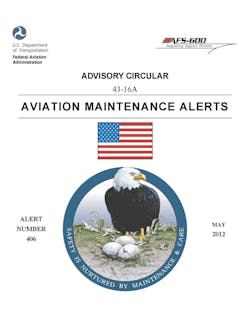May 2012 FAA Maintenance Alerts
Cessna Alternator: (P/N) 99105923; Brush Failure; ATA 2434
(This report references a Cessna T206H aircraft with a Lycoming TIO540AJ1A engine.)
"The alternator field circuit breaker tripped intermittently over the last 25 hours, (causing) various instances of radio noise," states this mechanic. "The alternator remained functional. (I) suspected possible brush failure, and elected to replace the alternator during an Annual Inspection. The alternator was disassembled—found the ground brush (to be) 0.375 inches long. The field brush was completely disintegrated, with the spring contacting the slip ring. This alternator is only available from the manufacturer. There are no known third party overhaul facilities. The aircraft manufacturer service documents provide no service or parts data. There are no aircraft manufacturer inspection protocols beyond external security checks. Brush and/or slip ring inspection can only be accomplished by disassembly of the case. I suggest a re-design to permit proper periodic inspection the brushes, make service and overhaul data available, and/or improve quality. Neither 'operation to failure' or 'periodic mandatory alternator replacement' is (acceptable)."
Part Total Time: 645.0 hours
Agusta: A119; Cracked Gleason Crown Gear; ATA 6320
A quality control supervisor for this repair facility says, "During a 4800 hour overhaul inspection, the Gleason Crown gear was found to have a crack."
Part Total Time: 4,854.0 hours
Cessna: 208B; Rudder Torque Tube Corrosion; ATA 5540
A repair station technician states, "This Hawaiian based aircraft arrived at our (facility) for maintenance. The rudder was removed from the aircraft, and its skin (then removed) to allow access to the rudder torque tube (P/N 263066-3). (This torque tube...) was scheduled to be replaced due to elongated holes in the bell crank. Severe corrosion was found on the upper part of the torque tube which is located under the skin — (this area) is not visible to any scheduled maintenance. The corrosion had reached the stage of 'blistered rust', and the 'L' angle on one side was easily separated with (minor) force (about 11 pounds; and wiggled twice)." "By design the rudder is not sealed on the top. The (torque tube top attach) bracket is located about a foot from the bottom — this cross member seems to pool water running down from inside the rudder (even though) there are drain holes in the design. Hawaii is listed as a 'moderate' corrosion environment. The operator had no way to inspect this location. A borescope would need to be used to (even) get an idea of the health of this part — (but still) it is better to remove and disassemble the (rudder). I would suggest a rudder inspection (hole be designed and implemented) so maintenance can easily inspect the torque tube for corrosion."
Part Total Time: 12,563.6 hours
